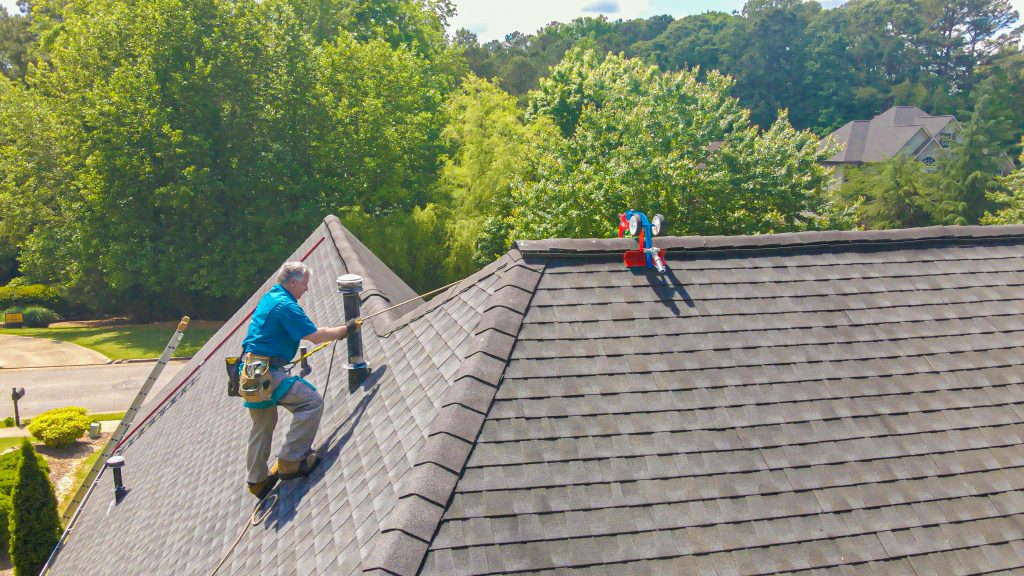
If you’re working on a particularly steep roof, then you know that safety is the number one priority. Working on steep or sloped roofs already present certain challenges, and it can be difficult to adhere to safety protocols. But ultimately, taking safety precautions and making proper preparations will not only save time in the long run, but it will also help you avoid any potential injuries or accidents.
We’ve put together the following tips on some of the issues steep roofs present, and how to work safely on a steep roof. Read on to learn more!
Why do some homes have steeper roofs?
So what defines a steep roof? OSHA’s definition is any roof that has a 4:12 roof or higher. One of the many benefits to a pitched roof is that they help the flow of rainwater or melting snow. When roofs are flat, puddles form and they lead to water damage, leaks, mildew and rot. Most homes do not have flat roofs, or if they do, they are in areas where rainy weather is uncommon.
You may have noticed that some roofs are far steeper than others. This can be for a few reasons:
1) The local codes require a specific slope.
2) The area is prone to a lot of rain and a standard slope might not be enough to drain water properly.
3) The home was designed with a steeper slope for the aesthetic appeal.
4) There’s a large room below the roof with a higher ceiling.
There are many reasons as to why homes should and do have steep roofs, but this doesn’t make them any easier to work on. If you’re going to be doing maintenance, repairs or construction on a rather pitched roof, below are our top tips to successfully complete your project safely.
Working on a steep roof safely
Use a ladder & ladder accessories
Whether you’re working with a team or on your own, having this standard piece of equipment is essential for roof work. Getting your ladder set up is your first important step before ascending the roof. Make sure you’re working on even ground, and if possible, always have someone at the bottom of the ladder for added security.
Ladder shoes, levelers and stabilizers are all excellent accessories, as they can provide quick fixes and prevent the ladder from slipping, and help make any roofing job easier, efficient and more productive.
If you’re going to be climbing two or more stories high, then we suggest using manufacturer recommended ladder stabilizers for extra stability. Of course, having a stable base is only part of the battle – you’ll also want to make sure the top of the ladder cannot slide or move when rested against the wall.
Ensure the right conditions
Don’t go up on a roof in wet weather, especially a very steep roof. Check the forecast ahead of time, and if it’s going to be raining, snowing or windy, schedule your roofing project for another day.
In addition to weather conditions, ensure that you’re also in good physical condition. If you’re feeling unwell or dizzy, do not attempt to go up on the roof.
Secure yourself safely to the roof
This is truly the most important part of any roofing project. Hipplock offers both a base and plus package for our system, which is lightweight, easy to set up and OSHA approved. When you’ve visually inspected the roof and are ready to ascend, follow these five steps:
1) Determine the slope using a pitch gauge, inclinometer, or smart level
2) Install the extension poles by locking them into place
3) Connect the lifeline to the HippLock frame and to the safety harness
4) Hang the Hipplock device from the gutter or ladder
5) Install the HippLock using the push pole system
For more information, watch this video on how to use the Hipplock system.
Getting off is just as important as getting on
Ascending and descending steep roofs are the greatest chances of falling or having an accident, which is why exercising supreme caution before disconnecting the Hipplock and getting down is so important. Every step of the way needs to be taken seriously, right from the beginning. Getting off of a roof can be challenging at first, but if you use Hipplock’s system alongside a sturdy and quality ladder, along with proper safety equipment, you should have no issues or accidents.
Roof safety is our number one concern
Whether you’re a roofer, painter, construction worker, or simply a homeowner, we want you to be safe from start to finish. Anyone who works on a high surface should always practice good safety protocols. Never take short cuts, and never compromise on safety in hopes of getting things done faster. Keep the above tips in mind, and always use Hipplock’s fall protection system to avoid injury or accidents when working on steep roofs.